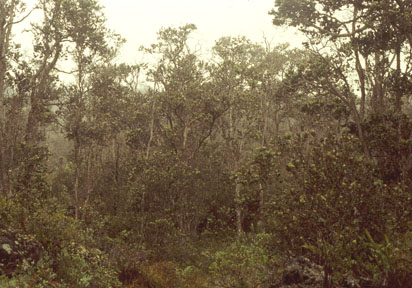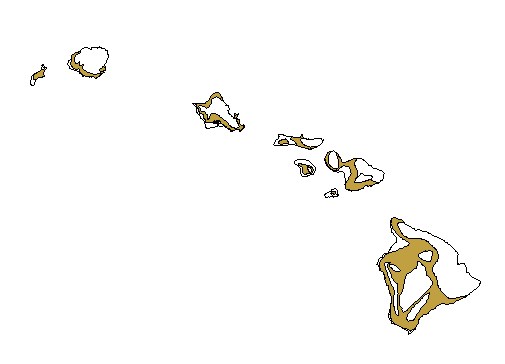
O'hia lehua (Metrosideros) forest, north slope of Mauna Loa, island of Hawaii (c) 2005 Carol and Steve Baskauf
Bioimages home (click on an image to enlarge)
view
this page in its intended navigation context
Hawaii tropical dry forests (WWF
ecoregion
OC0202)

O'hia lehua (Metrosideros) forest,
north slope of Mauna Loa, island of Hawaii (c) 2005
Carol and Steve Baskauf

Source of bioregions data:
Olson, D. M. and
E. Dinerstein. The Global 200: Priority ecoregions for global conservation. (PDF
file) Annals of the Missouri Botanical Garden 89:125-126.
Distinctiveness (1=highest,4=lowest): 1
(globally outstanding)
Dry forests harbor a number of specialist and endemic plant species.*
Conservation Status (1=most endangered, 5=most
intact): 1 (critical)
10% of Hawaiian dry forests remain. Development, conversion to agriculture
and pasture and burning continues to reduce the remaining habitat.
Introduced plant species, rats, and grazing by livestock and feral mammals
degrade existing habitats.*
 Metrosideros
spp.
Metrosideros
spp.

and other genera
Some views from the ecoregion
Primary succession on lava flows, island of Hawaii


(l) Lava from Pu'u 'O'o
eruption entering the sea, Chain of Craters Road, Hawaii Volcanoes Ntl. Park.
More images from this eruption
(r) Pahoehoe (smooth) and a'a (rough) lava, Hawaii Volcanoes Ntl. Park
(c) 2005
Carol and Steve Baskauf
hires
hires


(l) Primary succession on a'a lava, (r)
recent, older, and ancient lava flows, Chain of Craters Road, Hawaii Volcanoes
Ntl. Park
(c) 2005
Carol and Steve Baskauf
hires
hires


(l) O'hia lehua (Metrosideros) trees are important successional pioneers
on lava flows, Hawaii Volcanoes Ntl. Park (r)
Due to this, O'hia trees are often found in uniform-aged stands. North slope of
Mauna Loa, island of Hawaii (c) 2005
Carol and Steve Baskauf hires
hires
Manuka State Park, island of Hawaii


Parts of the mixed dry forest of Manuka are
relatively intact. However, the native flora has been negatively impacted
by destructive grazing by feral goats and pigs as well as invasive plant
species. (c) 2005
Carol and Steve Baskauf hires
hires

In this pit formed from a collapsed volcanic
structure, the steep walls have prevented damage from introduced feral animals.
Endemic plants cling to survival there.
(c) 2005
Carol and Steve Baskauf hires
kipuka,off Pu'u O'o Volcano Trail, Saddle Road, island of Hawaii


A kipuka is an intact patch of forest that was
surrounded by a lava flow. (l) From a distance on the lava flow, the trees
look relatively short. (r) However, after descending the steep sides of the
kipuka, one realizes that only the treetops were visable from outside and that
tall trees are present there.
(c) 2005
Carol and Steve Baskauf hires
hires


This particular kipuka was surrounded by a lava
flow in the 1800's. Therefore it has been isolated from other vegetation
for over 100 years. Because of their isolation, kipukas may have
relatively few invasive plants and are strongholds for native plant and bird
species. (l) canopy (r) lichens on tree branch
(c) 2005
Carol and Steve Baskauf
hires
hires
* Ricketts, T.H., E. Dinerstein, D.M. Olson, C.J. Loucks, et al. (1999) Terrestrial Ecoregions of North America: A Conservation Assessment. World Wildlife Fund - United States and Canada. Island Press, Washington, D.C. pp. 337-340.
Except as noted, images copyright 2002-2004 Steve Baskauf - Terms of use